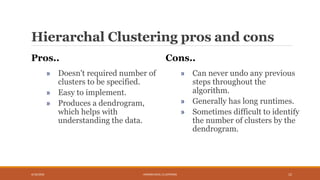Hierarchical clustering
- 1. Hierarchical clustering NAME - A.K.M.ASHEK FARABIPresented By:
- 2. Content •Clustering •Types of Clustering •Hierarchical Clustering •Key Concepts in Hierarchal Clustering •Types of Hierarchal Clustering •Difference between Partitional and Hierarchical clustering •The Application of Hierarchical Clustering •Hierarchical Clustering pros and cons •Summary 4/10/2018 HIERARCHICAL CLUSTERING 2
- 3. Clustering •Clustering is the classification of objects into different groups, or more precisely, the partitioning of a data set into subsets (clusters), so that the data in each subset (ideally) share some common trait - often according to some defined distance measure. 4/10/2018 HIERARCHICAL CLUSTERING 3
- 4. Clustering (cont..) •Also called “unsupervised learning” or “data mining” •Organizing data into classes such that there is • high intra-class similarity • low intra-class similarity •More informally, finding natural groupings among objects. 4/10/2018 HIERARCHICAL CLUSTERING 4
- 5. Clustering (cont..) What is a natural grouping among these objects? Clustering is subjective Rahim’s Family School Employs Females Males 4/10/2018 HIERARCHICAL CLUSTERING 5
- 6. Types of Clustering 1. Hierarchical algorithms 2. Partitional clustering 4/10/2018 HIERARCHICAL CLUSTERING 6
- 7. Hierarchical Clustering •Produces a set of nested clusters organized as a hierarchical tree. •Can be visualized as a dendrogram. »A tree-like diagram that records the sequences of merge or splits 4/10/2018 HIERARCHICAL CLUSTERING 7
- 8. Key Concepts in Hierarchal Clustering Dendrogram tree representation 2 3 4 5 6 object lifetime 1. In the beginning we have 6 clusters: A, B, C, D, E and F 2. We merge clusters D and F into cluster (D, F) at distance 0.50 3. We merge cluster A and cluster B into (A, B) at distance 0.71 4. We merge clusters E and (D, F) into ((D, F), E) at distance 1.00 5. We merge clusters ((D, F), E) and C into (((D, F), E), C) at distance 1.41 6. We merge clusters (((D, F), E), C) and (A, B) into ((((D, F), E), C), (A, B)) at distance 2.50 7. The last cluster contain all the objects, thus conclude the computation 4/10/2018 HIERARCHICAL CLUSTERING 8
- 9. Types of Hierarchal Clustering Two main types of hierarchical clustering • Agglomerative: » Start with the points as individual clusters » At each step, merge the closest pair of clusters until only one cluster (or K clusters) left • Divisive: » Start with one, all-inclusive cluster » At each step, split a cluster until each cluster contains a point (or there are K clusters) 4/10/2018 HIERARCHICAL CLUSTERING 9
- 10. Difference between Partitional and Hierarchical clustering Partitional clustering » Partitional clustering is faster than hierarchical clustering. » Partitional clustering requires stronger assumptions such as number of clusters and the initial centers. » partitional clustering algorithms require the number of clusters to start running. Hierarchical clustering » Hierarchical clustering is slower than Partitional clustering. » Hierarchical clustering requires only a similarity measure. » Hierarchical clustering does not require any input parameters 4/10/2018 HIERARCHICAL CLUSTERING 10
- 11. The applications of Hierarchical Applications » Wireless Sensor Network » Audio Event Detection » Web cluster engines » Bioinformatics » And many more. 4/10/2018 HIERARCHICAL CLUSTERING 11
- 12. Hierarchal Clustering pros and cons Pros.. » Doesn't required number of clusters to be specified. » Easy to implement. » Produces a dendrogram, which helps with understanding the data. Cons.. » Can never undo any previous steps throughout the algorithm. » Generally has long runtimes. » Sometimes difficult to identify the number of clusters by the dendrogram. 4/10/2018 HIERARCHICAL CLUSTERING 12
- 13. Summary •Hierarchical algorithm is a sequential clustering algorithm »Use distance matrix to construct a tree of clusters (dendrogram) »Hierarchical representation without the need of knowing of clusters (can set termination condition with known of clusters) •Major weakness of agglomerative clustering methods »Can never undo what was done previously »Sensitive to cluster distance measures and noise/outliers 4/10/2018 HIERARCHICAL CLUSTERING 13














